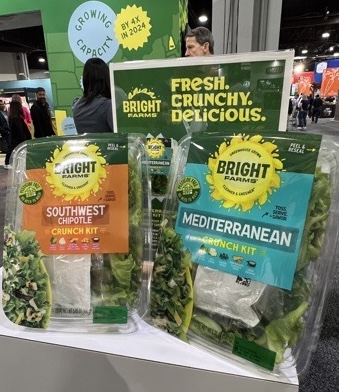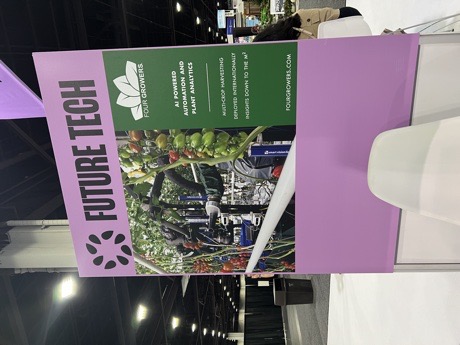10/29/2024
A Whirlwind at Global Produce & Floral Show
Jennifer Polanz
Holy moly, is Global Produce & Floral Show a BIG event. And it’s getting bigger—according to show runners, this year’s event in Atlanta was one of the largest expo floors in a decade, with more than 1,100 exhibitors from 32 countries. About 130 of those exhibited for the first time. And, one of our CEA growers received an award for it: Little Leaf Farms received best First-Time Exhibitor!
What did we see at the show? Well, what didn’t we see. But some of the continued trends included sustainable packaging, automation to reduce labor stressors and AI-driven technology. On the product introduction side, growers continued to expand salad kit offerings, as well as their tomato and pepper offerings. There’s a seedless mini pepper battle brewing as growers begin figuring out how to grow them effectively at a mass scale for zero seeds inside (it involves growing only seedless peppers in that greenhouse to prevent cross-pollination, which otherwise produces seeds). It does seem like this could be a nice niche product category for CEA to capitalize on, if the response from retailers and consumers is there.
In talking with lots of people on the exhibit floor, it was clear, too, Tomato Brown Rugose Fruit Virus (ToBRFV) continues to be an issue on the tomato side, and fusarium an issue on the pepper side. For rugose, it’s about prevention versus treatment, and I had included some information from an industry supplier about prevention a while back. You can find it HERE.
On the pepper side, I asked Bill Calkins, who works with Ball’s Tech Team, about some basic resources for Fusarium on peppers. He gave me links to University of Florida Extension information, as well as University of Minnesota Extension.
We’ll continue to cover these, too—if you are a researcher or breeder working on these two issues, please reach out to me at jpolanz@ballpublishing.com.
On to the New Products: Leafy Greens
 So what did we actually see at the show? Lots of new offerings from CEA growers. Unfortunately, we didn’t get to all the CEA grower booths, but we did hit quite a few. Here are a few new intros, first with leafy greens:
So what did we actually see at the show? Lots of new offerings from CEA growers. Unfortunately, we didn’t get to all the CEA grower booths, but we did hit quite a few. Here are a few new intros, first with leafy greens:
The indoor vertical farm leafy greens grower Bowery introduced four new spinach-focused products at the show. Spinach, of course, is the holy grail of leafy greens as it is very difficult to grow in hydroponic production. Bowery has seemingly cracked the code with a proprietary technology just for the spinach production. There are three blends, a Super Blend (a third each Spinach, Kale and Bok Choy), 50/50 Blend (half spinach and half spring mix) and Spinach & Butter blend, as well as Baby Spinach only. All are available in 4 oz., while the Baby Spinach and 50/50 Blend are available in 8 oz., too.

Bright Farms added two more new offerings to its lineup of salad kits for four total: Southwest Chipotle Crunch Kit and Mediterranean Crunch Kit. These are also peel and reseal so customers can mix their salad in the plastic, reseal and shake.
But the real story at this booth was the continued and rapid expansion under Cox Farms to eight locations. The new fully automated Yorkville, Illinois, location is in production now, and the Lorena, Texas, facility is slated to open next month. Meanwhile, Macon, Georgia, should be coming online in December. Each are starting at 8 acres in phase 1, and have the potential to expand in four phases for a total of 32 acres.

One way to differentiate at the shelf level is through packaging, and that’s what Sensei Farms intends with its new paperboard tray with removable liner. It allows for 90% less plastic packaging, and allows the consumer to see the product from all sides (there’s a window on the bottom, too). Once done with the product, the customer removes the top and the liner and can recycle the rest. Sensei has an interesting story, too. Originally started in 2016 on the Hawaiian Island of Lana’i with a 2-acre greenhouse, they now also have a more high-tech 30-acre growing facility in Leamington, Ontario.
Tomatoes & Peppers
 At the Mucci Farms booth they were highlighting their Savorries line of sweet strawberry tomatoes, which Communications Manager Ajit Saxena said was their fastest growing SKU. Why? The high sugar content means a sweet bite and great flavor for the end consumer. Plus, the tomatoes are disease-resistant, i.e. rugose resistant, which means consistency of supply to grocery customers.
At the Mucci Farms booth they were highlighting their Savorries line of sweet strawberry tomatoes, which Communications Manager Ajit Saxena said was their fastest growing SKU. Why? The high sugar content means a sweet bite and great flavor for the end consumer. Plus, the tomatoes are disease-resistant, i.e. rugose resistant, which means consistency of supply to grocery customers.
Mucci also was one of the growers introducing a seedless pepper with its new Senza packaged pepper product (Senza means “without” in Italian). He said so far the response had been positive at the show from potential buyers.

Village Farms added to its Heavenly Villagio Marzano line of plum tomatoes with a new orange and yellow offering, as well as a mix of red, orange and yellow in its Trio product. These are meatier tomatoes great for sauce, as well as for cooking, roasting and sauteing.
 Pure Flavor had several new introductions at the show, including the new orange OMG tomatoes being grown in Canada with a sweet burst of flavor and a nice crunch for snacking and salads. They also introduced Rocco Red chef’s tomato-on-the-vine, a versatile offering that is great for saucing as well as for cooking and for salads. Here Director of Marketing Julia Shreve is showing off the Rocco Red packaging. Pure Flavor also introduced its seedless mini peppers at the show, simply called Seedless, which Julia said retailers are starting to ask for as grocery and consumers move more in this direction.
Pure Flavor had several new introductions at the show, including the new orange OMG tomatoes being grown in Canada with a sweet burst of flavor and a nice crunch for snacking and salads. They also introduced Rocco Red chef’s tomato-on-the-vine, a versatile offering that is great for saucing as well as for cooking and for salads. Here Director of Marketing Julia Shreve is showing off the Rocco Red packaging. Pure Flavor also introduced its seedless mini peppers at the show, simply called Seedless, which Julia said retailers are starting to ask for as grocery and consumers move more in this direction.
Melons Under Cover
 We’ve reported in this space before about the greenhouse-grown melons that Pure Flavor came out with the past two years. This year they had a third mini melon introduction in amora, which won Best Product Promo from the International Floral & Produce Association (IFPA). These are single-serving melons with vibrant colors and a sweet, juicy taste.
We’ve reported in this space before about the greenhouse-grown melons that Pure Flavor came out with the past two years. This year they had a third mini melon introduction in amora, which won Best Product Promo from the International Floral & Produce Association (IFPA). These are single-serving melons with vibrant colors and a sweet, juicy taste.

The Sunset brand has joined the fray in mini melons with its own new introduction, Kawaii, also offering a single serving with juicy sweetness. This melon variety hails from Japan, and they, too, are growing these melons in greenhouses in Mexico. It will be sold in 2-pack mesh bags or in bulk.
New Technology
 There was a ton of new tech there at the show, but I’m picking one to highlight that caught my eye: Four Growers is a startup from Pittsburgh that has a tomato-harvesting robot driven by AI called the GR-100. What’s different about this robot versus others is the method for harvesting—instead of picking the fruit with a robotic “hand” it gently sucks it off the vine vacuum-style.
There was a ton of new tech there at the show, but I’m picking one to highlight that caught my eye: Four Growers is a startup from Pittsburgh that has a tomato-harvesting robot driven by AI called the GR-100. What’s different about this robot versus others is the method for harvesting—instead of picking the fruit with a robotic “hand” it gently sucks it off the vine vacuum-style.
I talked to Sales Director Nick Boelen at the booth, who said it’s as fast as a human and getting faster all the time. It has four cameras on each side that identifies the fruit to be picked and through machine learning knows which ones are ripe enough, and they are beta testing yield forecasting based on the imaging, as well. There are multiple nozzle sizes available depending on the crop. Currently there are prototypes in one Canadian grower and two Dutch growers, and he said they just closed on a new round of fundraising to continue to build machines.
The company also is developing a proof of concept for a cucumber harvesting machine that does use a 3-fingered “hand” along with a cutting device.